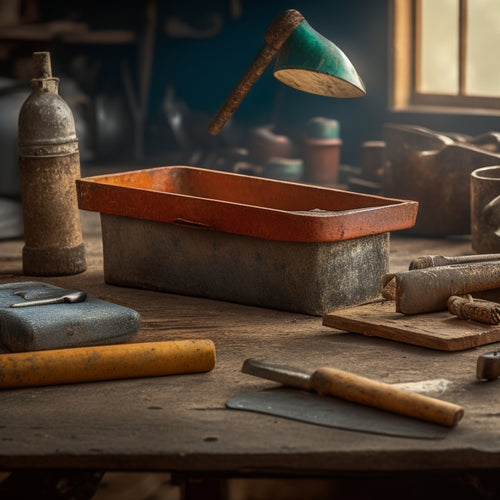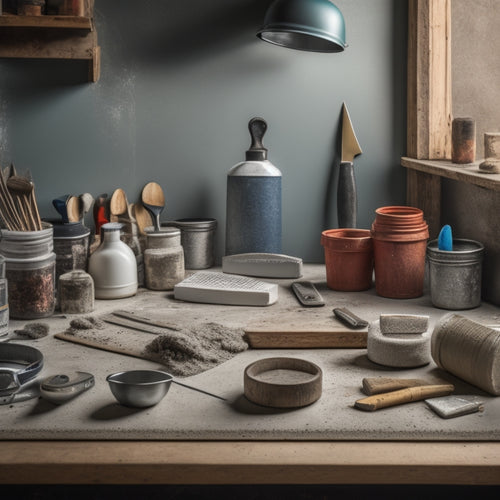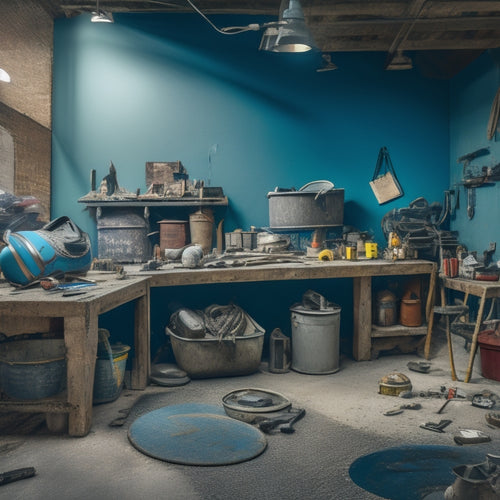
Essential Tools for Concrete Adhesion DIY Success
Share
To guarantee a strong and durable bond between old and new concrete, you'll need a range of essential tools. For surface preparation, you'll require power washers, acid etchers, and mechanical scrubbers, as well as specialized tools like scarifiers and grinders. For bonding agent application, high-precision applicator guns or notched trowels are necessary, while testing and inspection tools like pull-off testers and moisture meters help assess bond strength and durability. Accurate mixing and measuring tools, like mixing buckets and measuring cups, are also critical. Finally, safety gear like heavy-duty gloves and dust masks are a must. By understanding these tool requirements, you'll be well on your way to achieving a successful concrete adhesion project.
Key Takeaways
• Use surface preparation tools like power washers, acid etchers, and scarifiers to create a strong bond between old and new concrete.
• Select the right bonding agent application tools, such as applicator guns or notched trowels, to ensure a uniform coating and optimal performance.
• Invest in testing and inspection tools, including pull-off testers and moisture meters, to assess bond strength and detect potential issues early.
• Accurate mixing and measuring tools, like mixing buckets and measuring cups, are crucial for achieving the correct proportions and a strong bond.
• Don't forget essential safety gear, including heavy-duty gloves and safety glasses, to minimize risks and prevent injuries during the concrete adhesion process.
Concrete Surface Preparation Tools
You'll need to employ a range of concrete surface preparation tools to guarantee a strong bond between the old concrete and the new material. This essential step ensures that the substrate is properly cleaned, roughened, and assessed to create an ideal bonding surface.
To begin, you'll need to utilize surface cleaning techniques, such as power washing, acid etching, or mechanical scrubbing, to remove dirt, oil, and other contaminants that can compromise adhesion.
Next, you'll need to assess the substrate using substrate assessment methods, including moisture testing, pH testing, and surface profilometry, to determine its porosity, texture, and other vital properties. This information will inform your selection of the most suitable bonding agent and application technique.
Additionally, you may need to use specialized tools, such as scarifiers or grinders, to roughen the surface and create a more receptive bonding environment.
Bonding Agent Application Tools
What type of tool do you need to apply bonding agents efficiently and effectively, guaranteeing a uniform coating and perfect adhesion performance?
To achieve ideal results, you'll require tools that cater to the specific bonding agent types and application techniques you're using. For example, when working with epoxy-based bonding agents, you'll need a high-precision applicator gun or a notched trowel to guarantee accurate and even distribution. On the other hand, acrylic-based agents may require a roller or brush for a more textured finish.
It's essential to choose the right tool for the job, as this will directly impact the bonding agent's performance. A high-quality tool will help you achieve a uniform coating, which is critical for ideal adhesion.
Additionally, the tool should be designed for the specific application technique you're using, whether it's spraying, brushing, or troweling. By selecting the correct bonding agent application tool, you'll be able to achieve a strong, durable bond that meets your project's requirements.
Testing and Inspection Tools
After ensuring a uniform coating with the right bonding agent application tool, apply the same level of precision to the testing and inspection process by employing specialized tools that accurately assess the bond's strength and durability.
You'll need tools that can quantify adhesion strength, identify potential weaknesses, and detect underlying issues that could compromise the bond. A pull-off tester, for instance, measures the bond's tensile strength by applying a controlled force to the surface. This data helps you determine if the bond meets the required standards.
Moisture assessment is another critical aspect of testing and inspection. Excessive moisture can greatly reduce adhesion strength, leading to premature failure. A moisture meter helps you detect and quantify moisture levels in the substrate, allowing you to take corrective action before applying the bonding agent.
Additionally, a visual inspection kit enables you to examine the surface for signs of contamination, porosity, or other defects that could impact adhesion. By using these testing and inspection tools, you'll be able to identify and address potential issues early on, ensuring a strong, durable bond that meets your project's requirements.
Mixing and Measuring Tools
Mixing and Measuring Tools
Accurate mixing and measuring of the bonding agent are vital steps in the concrete adhesion process, as they directly impact the bond's strength and durability. You must guarantee that the bonding agent is mixed correctly to achieve the desired consistency and properties. This requires using the right mixing techniques, such as slow and steady mixing, to avoid introducing air pockets or over-mixing.
Measuring accuracy is also essential, as incorrect proportions can lead to a weak bond. You'll need measuring cups or scales that can accurately measure the bonding agent and aggregate components.
Here are some important mixing and measuring tools you'll need:
| Tool | Description | Importance |
|---|---|---|
| Mixing bucket | A clean, dry bucket for mixing the bonding agent | Prevents contamination and guarantees accurate mixing |
| Mixing stick | A sturdy stick or paddle for mixing the bonding agent | Guarantees thorough mixing and prevents air pockets |
| Measuring cups | Accurate measuring cups for measuring bonding agent and aggregate | Guarantees correct proportions for a strong bond |
| Scale | A digital or mechanical scale for measuring components | Provides precise measurements for ideal bonding |
| Spatula | A flexible spatula for scraping the sides of the mixing bucket | Guarantees all material is well-mixed and incorporated |
Safety and Protection Essentials
You must wear appropriate safety gear and protective equipment to minimize risks and prevent injuries when working with concrete adhesion materials. This isn't an area where you can afford to cut corners, as the consequences of neglecting safety protocols can be severe.
Invest in a pair of heavy-duty gloves, safety glasses, and a dust mask to protect yourself from harsh chemicals and abrasive particles.
Confirm your protective gear is in good condition, and replace it regularly to guarantee maximum performance.
In addition to wearing the right gear, it's crucial to adopt sound safety practices. Always read the instructions and safety data sheets (SDS) before handling any material, and follow the recommended application procedures.
Assure good ventilation in your workspace, and avoid eating or drinking while working with concrete adhesion materials.
By prioritizing safety and adhering to best practices, you'll be able to complete your project with confidence and avoid costly setbacks.
Frequently Asked Questions
Can I Use a Regular Drill for Mixing Concrete Adhesive?
When it comes to mixing concrete adhesive, you're probably wondering if a regular drill will get the job done.
The answer is, it depends on the drill type and your mixing techniques. A standard drill mightn't provide the necessary torque or speed for thorough mixing, leading to inconsistent results.
You'll want to take into account a drill specifically designed for mixing, such as a hammer drill or a mixing drill, to guarantee a strong bond.
How Long Does Concrete Adhesive Take to Fully Cure?
As you wait for the concrete adhesive to transform from a viscous liquid to a rock-solid bond, you're likely wondering how long it'll take to fully cure.
Imagine a slow-burning fire, gradually building intensity – that's the curing process.
Typically, it takes 24 hours for the adhesive to reach 50% strength, but it's not until 7-10 days that it reaches its maximum adhesive strength, allowing you to put your DIY project to the test.
Is It Necessary to Prime All Concrete Surfaces Before Application?
When working with concrete adhesives, you'll often wonder if priming all surfaces is necessary. The answer is yes, it's essential.
Priming benefits include enhanced bonding, reduced adhesive consumption, and improved durability. Proper surface preparation is key to a successful application.
By priming, you guarantee a clean, porous surface for the adhesive to anchor to, resulting in a strong, long-lasting bond.
Don't skip this step, as it can lead to costly rework or even project failure.
Can I Apply Concrete Adhesive in Direct Sunlight or High Winds?
When applying concrete adhesive, you need to carefully consider the application conditions.
Direct sunlight and high winds can greatly impact the adhesive's performance, leading to reduced bonding strength and uneven drying.
To achieve the best results, you should avoid applying the adhesive in extreme weather conditions.
Instead, opt for shaded or covered areas with minimal wind exposure to guarantee a strong, long-lasting bond.
Are There Any Eco-Friendly Concrete Adhesives Available on the Market?
As you venture into the world of concrete adhesives, you're probably wondering if there's a greener way to get the job done.
Hold your breath, because the answer is yes! Eco-friendly concrete adhesives are slowly but surely taking center stage.
Look for products that utilize natural bonding agents and sustainable materials, reducing the environmental footprint of your project.
These innovative adhesives not only align with your values but also deliver impressive performance, making them a game-changer in the industry.
Conclusion
You've made it this far, and now you're ready to tackle your concrete adhesion DIY project.
Don't think that skipping one or two essential tools will save you time or money - it'll only lead to costly rework or even structural failure.
Invest in the right tools, and you'll guarantee a strong, lasting bond that'll withstand the test of time and harsh environmental conditions.
Related Posts
-

Smart Guide to Buying Used Concrete Hand Tools
You're about to buy used concrete hand tools, and you need to get it right. Dedicate time to identify the tools you n...
-

Essential Tools for Concrete Wall Covering Projects
When tackling a concrete wall covering project, you'll need a range of essential tools and equipment. For cleaning an...
-

What Tools Do You Need for Concrete Flooring
You'll need a thorough arsenal of specialized tools to achieve a high-quality, professional-looking concrete floor, i...


